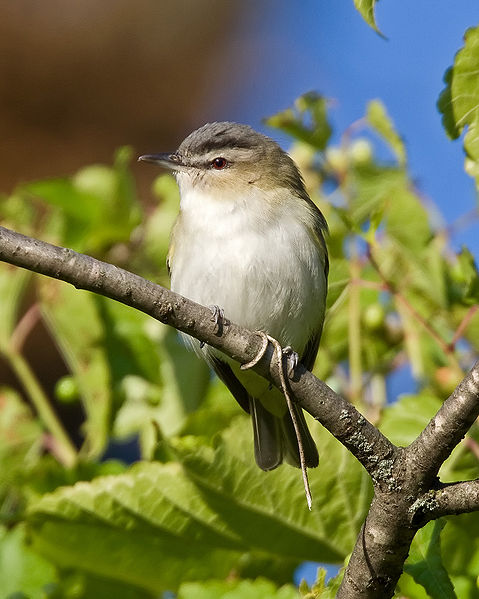 The vireos are a group of small to medium sized birds with dull gray to greenish plumage that allows them to blend in with the foliage they inhabit. They are easy to attract to a backyard but difficult to observe once they arrive because of both their camouflage and the fact that they dart around so quickly. They inhabit deciduous trees and shrubs where they feed mostly on insects with a side of fruit. Vireos migrate south in the fall and return in the spring following the rise and fall of the insect population, so don’t be disappointed if they are not around in winter.
The vireos are a group of small to medium sized birds with dull gray to greenish plumage that allows them to blend in with the foliage they inhabit. They are easy to attract to a backyard but difficult to observe once they arrive because of both their camouflage and the fact that they dart around so quickly. They inhabit deciduous trees and shrubs where they feed mostly on insects with a side of fruit. Vireos migrate south in the fall and return in the spring following the rise and fall of the insect population, so don’t be disappointed if they are not around in winter.
Planting for vireos focuses on growing shrubs and trees that provide both cover and and food. those that produce flowers that attract insects and then produce fruit are especially valuable.
 Barberry (Berberis spp. and cultivars)
Barberry (Berberis spp. and cultivars)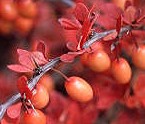 These deciduous shrubs have small leaves, lots of thorns, small flowers, and small berries. There are many attractive cultivars with both red and yellow foliage to add color to your garden while providing both food and nest sites for the vireos. Thrushes and wrens will also enjoy the berries while warblers will dine on the insects attracted by the flowers. Cultivars vary in the abundance of their flowers and fruits so make your selection carefully
These deciduous shrubs have small leaves, lots of thorns, small flowers, and small berries. There are many attractive cultivars with both red and yellow foliage to add color to your garden while providing both food and nest sites for the vireos. Thrushes and wrens will also enjoy the berries while warblers will dine on the insects attracted by the flowers. Cultivars vary in the abundance of their flowers and fruits so make your selection carefully
Size:
-
- To 5′ H
Site:
-
- Full sun but tolerate partial shade; medium moist well-drained soil
Hardiness:
- Zones 3-9
 Bayberry (Malus pensylvanica)
Bayberry (Malus pensylvanica)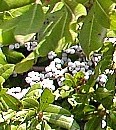 A native of eastern United States, bayberry is semi-evergreen to deciduous shrub or small tree that provides both food and cover for vireos. It produces male and female flowers on different plants so both genders must be planted to ensure berries. The berries persist into spring so are food for migratory vireos as well as other birds such as tree swallows, thrushes, wrens and warblers.
A native of eastern United States, bayberry is semi-evergreen to deciduous shrub or small tree that provides both food and cover for vireos. It produces male and female flowers on different plants so both genders must be planted to ensure berries. The berries persist into spring so are food for migratory vireos as well as other birds such as tree swallows, thrushes, wrens and warblers.
Size:
-
- 5-10′ H
Site:
-
- Full sun to partial shade; infertile, dry, acidic soil; salt tolerant
Hardiness:
- Zones 3-6
 Roses (Rosa spp.)
Roses (Rosa spp.)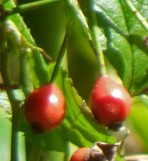 There are thousands of roses available but choose ones that produce small hips. Species roses and roses with small flowers are most likely to have the best hips for vireos. Thrushes, woodpeckers, flycatchers and jays are some of the birds that also like the hips. Cardinals may choose the rose bushes for nesting.
There are thousands of roses available but choose ones that produce small hips. Species roses and roses with small flowers are most likely to have the best hips for vireos. Thrushes, woodpeckers, flycatchers and jays are some of the birds that also like the hips. Cardinals may choose the rose bushes for nesting.
Size:
-
- To about 6′ H
Site:
-
- Full sun; fertile, moist but well-drained soil
Hardiness:
- Zones 3-9 depending on the variety
 Native Viburnums such as V. acerifolium, V dentatum, V. lantanoides, and V. nudum
Native Viburnums such as V. acerifolium, V dentatum, V. lantanoides, and V. nudum There are many native viburnums so select one that does well your area. They are deciduous shrubs with large clusters of small flowers that give way to cluster of small soft berries. Plants will form clumps or small thickets that provide cover, nest sites, and food. Thrushes, woodpeckers, flycatchers and other birds will enjoy the berries too.
There are many native viburnums so select one that does well your area. They are deciduous shrubs with large clusters of small flowers that give way to cluster of small soft berries. Plants will form clumps or small thickets that provide cover, nest sites, and food. Thrushes, woodpeckers, flycatchers and other birds will enjoy the berries too.
Size:
-
- 6-10′ H
Site:
-
- Full sun to part shade; medium moist, well-drained soil
Hardiness:
- Zones 3-8
 Grapes (Vitis spp.)
Grapes (Vitis spp.)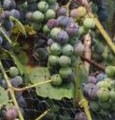 Native grapes such as V. riparia, V. labrusca, and V. rubra are deciduous vines that produced fruit that popular with vireos as well as with thrushes, woodpeckers, flycatchers, warblers, jays, orioles, and tanagers. V. labrusca includes the cultivar ‘Concord’ and is the grape juice grape.
Native grapes such as V. riparia, V. labrusca, and V. rubra are deciduous vines that produced fruit that popular with vireos as well as with thrushes, woodpeckers, flycatchers, warblers, jays, orioles, and tanagers. V. labrusca includes the cultivar ‘Concord’ and is the grape juice grape.
Size:
-
- up to 20+’ length
Site:
-
- Sun, medium moist, well-drained
Hardiness:
- Zones 4-9
